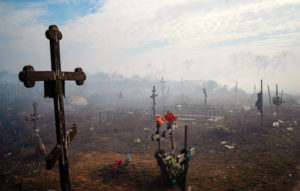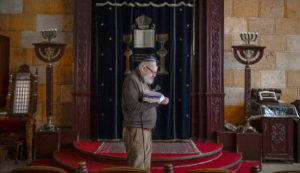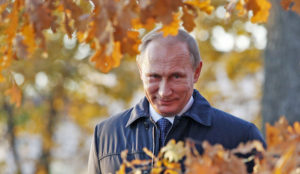Dnipro, Ukraine
To arrive in Dnipro is to not quite cross a Rubicon. The city sits at the centre of the Dnieper River, the body of water that sunders Ukraine — both practically and psychologically. It starts in the Valdai Hills near Smolensk in west Russia and runs for 1,400 miles through Belarus and Ukraine all the way into the Black Sea.
The Dnieper divides the country up into its left and right banks, a bifurcation that dates from the 17th century, during a period known as The Ruin, when the Polish-Lithuanian commonwealth and Russia fought over the area. Since then, most things east of the Dnieper have had a more Russian feel, while the West has been more European. It’s where the highest concentration of Russian-speakers and pro-Russian sentiment can be found, and where Russian forces chose to invade in 2014, setting up “separatist” republics in the Donetsk and Luhansk Oblasts (regions) which have nested like lice on the Ukrainian body politic ever since.
Standing between the left and right banks, Dnipro is accordingly of neither. It lies between Ukraine’s two worlds: West and East; Europe and Russia. Its geographical location makes it vital to the country war effort. It is the first stop on my journey to the battlefields of eastern Ukraine.
We pull into the station: large, cream and fronted by stolid columns. It’s impressive, like so many railway terminals in the former USSR. It’s also haunted. The diaries of the journalist Gareth Jones detail his experiences of the Moscow-enforced famine in Ukraine, the Holodomor. When Jones visited the station, it was filled with Ukrainian peasants slowly dying from hunger. I see them every time I come here.
The war between Russia and Ukraine is over territory and nationalism and language, which is to say that it is in large part about historical memory. And the memories are both contested and raw.
Dnipro’s central location makes it the country’s most important logistical hub. On a map, the roads and tracks sprawl out from the city like veins across the top of a fist. From Dnipro you can travel quickly south to the battlefields of Zaporizhzhya and the killing fields of Mariupol. Or you can go east to Kramatorsk and the separatist cities of Donetsk and Luhansk.
The Russians attacked Dnipro on the first day of the war, hitting and destroying the runway; they then struck military bases around the city. Two weeks later, they hit the airport again, and then again on 10 April, destroying it completely. The airport was also the scene of the infamous Russian “double tap”: a tactic several Ukrainians warn me about before I go to the front. It sums up the calculated sadism of the Russian way of war here. It was first struck at around 10am; the Russians then waited for the emergency services to get to the scene before striking it again at 12pm and hitting the fire crew that had arrived. Six firefighters were wounded, one, Eugeniya Dudka, severely.
But the city began to fight back — and not just its soldiers. When I first came to Ukraine to cover the war in 2014, the state was so broke that many of their soldiers fighting in the east lacked the basics: flak jackets and night vision goggles. Many didn’t even have proper uniforms. Ordinary Ukrainians stepped in: using social media to crowdfund money for the equipment, which they then often drove to the front themselves. They became, as I described in War in 140 Characters, a kind of virtual state, doing the things the government could not. Their efforts were vital to the war effort then and remain so almost eight years later.
In a cafe in the centre of the city with sandbags piled up against windows I meet Dima, a soldier in the Dnipro 1 Battalion, who works in IT but has been fighting the Russians off and on for almost eight years. “Look,” he told me. “The only things from the government I have on me are my machine gun and its bullets. Everything else, from my uniform to my German boots, comes from donations.” Dima heads up the battalion’s drone unit and he tells me that he raised $20,000 from friends and IT guys he knows to buy the drones they need.
The fundraising and donations are only possible because of the work of a class of Ukrainian civil society that spans almost all sectors of life and makes use of all available civilian tools. The “volunteers”. Ask a Ukrainian packing boxes of underwear to send to the front what he is and he’ll tell you: “I’m a volunteer.” Ask one sorting flak jacket into piles by size and she’ll say the same. As will the one cooking several pans of pasta on different stoves or the one standing outside the supermarket with lists of goods that people walking in can buy inside for soldiers at the front. They are no longer just a feature of civil society, but vital to the effective running of the state in war
Roman Uvarov was shaken awake by his wife at seven am on the first day of the war. “Russia is bombing us,” she hissed. Uvarov was shocked. He had assumed the conflict wouldn’t move beyond the Russian border areas where there was anyway a lot of pro-Russia sentiment. He never dreamed they would try to take the whole country. “Life just stopped,” he tells me. “Everything froze. I had no desire for work, no desire to play with my kids or to do anything really.”
But that didn’t last. “Something switched in me,” he continues. “I knew I had to do something.” So he began to do some casual “volunteering”. It started small. It was February and freezing, and people were looking for heaters. Ok, he thought, I have a spare heater in my garage. Then it was blankets. Then bed covers for the hospital and then medicine…
“I started buying all that stuff — it was minor, but it kept me motivated and made me feel that I wasn’t useless.” Like all Ukrainians he got creative, a much-needed skill when his country is facing an enemy so much larger and richer and well-armed. One of Uvarov’s hobbies was home brewing; he had loads of empty wine bottles lying around so he took them to his neighbour and the two of them started making Molotov cocktails.
The war was getting worse, though; more people were dying. He needed more resources — and global attention.
He started posting messages on Facebook to crowdfund. He got money from three friends abroad but, still, it wasn’t enough to make a real difference. He had to do something significant. He knew there was a lot of money in blockchain and building online marketplaces — he is an IT project manager — and so decided, with a friend, to introduce Ukrainian art to the crypto communities. The helpukrainestopwar.com project was born. It grew quickly. Artists brought other artists who brought friends and it ballooned.
Uvarov was convinced he could do more. He knew there was money to be made in NFTs, and came up with a simple idea: Ukraine Stands United. It is an NFT collection created by Ukrainian artists which they are selling in the hope of raising 1 million ADA — a coin of the Cardano blockchain that has at the time of writing a rate of 1 ADA to $0,80. It will provide 30,000 ministry standard meals to those on the ground on a weekly basis, alongside essentials such as medicine and transport.
What is so striking about Uvarov’s story is how ordinary — and yet extraordinary — it is. He knew the soldiers needed meals but who could prepare them? He had a favourite pizza and sushi delivery place in Dnipro, Rock’n’Roll, and convinced them to start cooking for what he calls the “defenders”.
Uvarov hands me a rectangle of silver foil the size of a paperback. It’s an MRE (Meal-Ready-to-Eat) containing rice and stewed chicken. Uvarov and the guys started out with their own money and made 500 meals in their first batch. Now they have a team of 15-20 people in production (all of whom cooked sushi and pizza before the first Russian strike on 24 February) who are making 5,000 packets a day. But demand is increasing.
I look at Uvarov. With his dark blue jeans, white hoodie and gold earring, he could be a fresh-faced IT professional from London or New York. Instead, he is integral to his country’s future. Ukraine cannot survive without its army, and its army cannot survive without him.
He looks at me. “I’m a volunteer not a soldier,” he says. “I’m not ready to die for Ukraine, but I am determined to live for it.”
Disclaimer
Some of the posts we share are controversial and we do not necessarily agree with them in the whole extend. Sometimes we agree with the content or part of it but we do not agree with the narration or language. Nevertheless we find them somehow interesting, valuable and/or informative or we share them, because we strongly believe in freedom of speech, free press and journalism. We strongly encourage you to have a critical approach to all the content, do your own research and analysis to build your own opinion.
We would be glad to have your feedback.
Source: UnHerd Read the original article here: https://unherd.com




